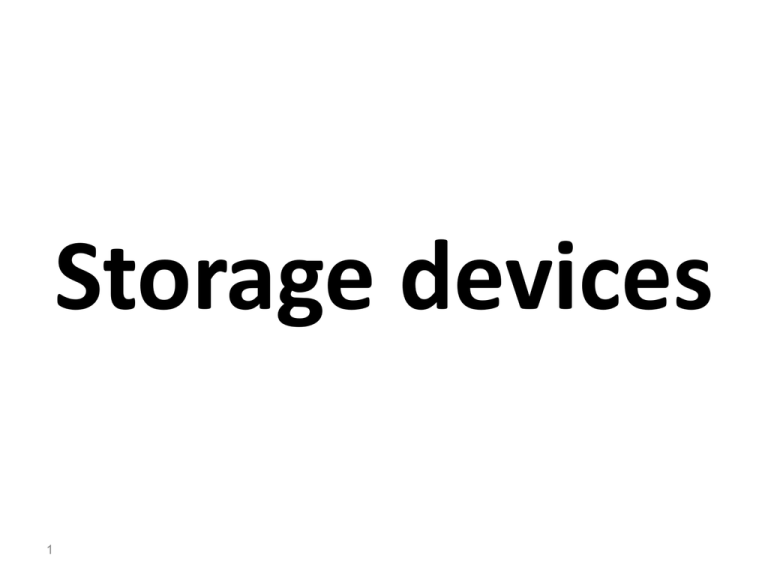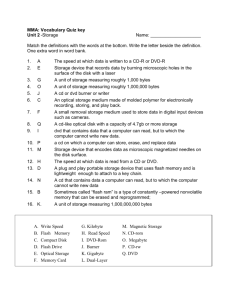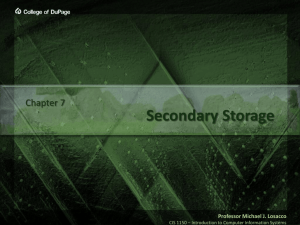Chapter 2 part 2
advertisement

Storage devices 1 Storage • Storage device : stores data and programs permanently its retained after the power is turned off. • The most common type of storage device is hard drive. 2 Storage • All information on computers are stored in files. • The computer store data in the form of bytes (8-bit) a storage medium can hold a number of Bytes . • A byte is approximately one character ( letter ‘a’, number ‘1’ , symbol ‘?’ etc…). 3 Units of Measurements 1- Bit : the smallest unit. It holds a single value, ether 1’s or 0’s . 2- Byte : A byte consist of 8 bits.[Byte=8bits] 3- Kilobyte : consist of 1024 bytes.[KM=1024bytes]. 4- Megabyte : consist of 1024 KM.[MB=1024KM]. 5- Gigabyte : consist of 1024 MB.[GB=1024 MB]. 6- Terabyte : consist of 1024 GB.[TB=1024GB]. 4 TYPES OF Storage Primary storage (Internal storage) 5 Secondary storage (External storage) Storage • Primary storage – Volatile storage(changeful) – Temporary storage 6 • Secondary storage – Nonvolatile storage – Permanent storage Secondary Storage • Secondary storage permanently saves information for future use; to share information with others; to modify at later date. • Secondary storage is nonvolatile – stores programs and data as opposed to temporary storage (RAM). • Characteristics include: • Media or medium – actual physical materials that holds the data and programs. • Capacity – measures how much a particular storage medium can hold. • Storage devices – hardware that reads data and programs from storage media (most also write to storage media). • Access speed or access time – measures the amount of time required by the storage device to retrieve data and program. 7 Secondary Storage • Writing – process of saving information to the secondary storage device. • Reading – process of accessing information from secondary storage. 8 Secondary Storage Devices - Examples of secondary storage devices : floppy disks, hard disks, and optical disk drives. 8-9 1-Floppy Disk Drives (FDD) - Floppy disk called diskettes : are Portable or removable storage media , inexpensive. - Typically used to store and transfer small word processing, spreadsheet, and other types of files. - Also called flexible disks and floppies - Stores 100 MB, 250 MB or 750 MB capacity 10 2-Hard Disks * Faster than a floppy diskette * Large capacity *Today the standard hard disk stores 150 GB or more. 11 Types of Hard Disks 1- Internal Hard Disk 2- External Hard Disk 12 Internal Hard Disk - Located inside the system unit -Used for storing the operating system, other programs, and large data files - You should perform routine maintenance and periodically backup all important files 13 Internal Hard Disk 14 External Hard Disk *An external hard disk is easy to use. *Located outside the system unit . *The same as internal hard disk, more expensive . 15 3- Optical Disks - Use laser technology to provide high capacity storage. - It is flat, circular, plastic or glass disk on which data is stored in the form of light and dark pits. - The two most common are : 1-Digital Versatile Disc (DVD) 2-Compact Disc (CD) 16 3- Optical Disks • Compact, high capacity form of permanent storage (up to 50 gigabytes of data). • Optical discs are read by an optical disc drive. • Laser beam writes by creating a pattern of pits (holes) and lands (flat areas) to encode data bits. • Laser beams reflect off the pits and lands to read the data. • Rotational speed determines how fast data can be transferred from the CD. • Optical disks come in many different sizes. • Most common is 4 ¾ inches. • Stored in a protective case called jewel boxes. 17 Compact Disc (CD) *Three basic types of CD’s : -Read only: CD-ROM -Write once: CD-R -Rewriteable: CD-RW 18 Compact Disc 1-Read only CD-ROM: compact disk read only memory and cannot be erased or modify contents. 2-Write once CD-R: ( compact disk-recordable) disk you can write to only once. 3- Rewriteable CD-RW: (compact disk-rewritable) Erasable disk you can write on many times , that can be erased and written to with the new information. 19 Digital Versatile Disc (DVD) *Digital Versatile Disc or Digital Video Disc (DVD) *Similar to CDs, but can store more data *Three basic types: -Read only: DVD-ROM -Write once: DVD+R; DVD-R -Rewritable: DVD+RW; DVD-RW; DVD-RAM 20 1- Read only -DVD-ROM: Known as DVD players. Used for videos. 2-Write once -DVD-R and DVD+R: Write once format Two competing write once formats. Used to create permanent archives for large amounts of data and to record videos. 3-DVD-RAM or DVD+RW or DVD-RW– rewritable: Use to store video from camcorders and developing large multimedia presentations that include extensive graphics and video 21 Other Types of Storage 1) Solid-state storage • Flash memory cards. • USB drives . 2) Magnetic tape. • VCR tape (Video Cassette Recorder ). 22 Other Types of Storage Solid-state storage • No moving parts. • Reliable, but expensive. • Requires less power. Magnetic tape • Slower sequential access. • Stores data and programs. • Used for making backups of data. 23 Solid-State Storage • Flash memory cards : - Widely used in notebook computers - This type of storage device has no moving parts. - They are commonly used in many electronic devices, including : digital cameras, mobile phones, laptop computers, MP3 players, and video game consoles. 24 Solid-State Storage • USB drives - Also known as flash drive , pen drive , or key drive. - Connects to a USB port - Easy to use and flexible, a cheap .price, called a removable disk, multiple forms 25 Identify the Device 26 Identify the Device 27


